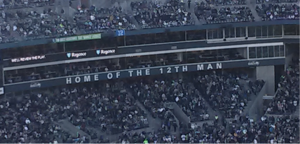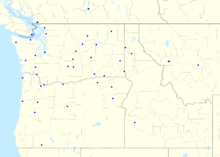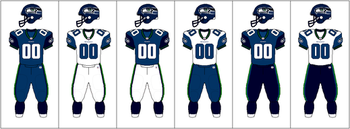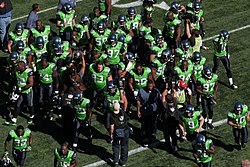12th Man
See also: 12th man (football)
"Home of the 12th Man" signage within CenturyLink Field in 2013.
A giant #12 flag of the Seattle Seahawks
In 2002, the Seahawks began playing at what is now CenturyLink Field. Every regular season and playoff game at CenturyLink Field since the 2nd week of the 2003 season has been played before a sellout crowd.[44] Like the Kingdome before it, CenturyLink Field is one of the loudest stadiums in the league. The stadium's partial roof and seating decks trap and amplify the noise and bang it back down to the field. This noise has caused problems for opposing teams, causing them to commit numerous false-start penalties. From 2002 through 2012, there have been 143 false-start penalties on visiting teams in Seattle, second only to the Minnesota Vikings.[45]
The Seahawks' fans have twice set the Guinness World Record for the loudest crowd noise at a sporting event, first on September 15, 2013, registering 136.6 dB during a game against the San Francisco 49ers[14] and again on December 2, 2013, during a Monday Night Football game against the New Orleans Saints, with a roar of 137.6 dB.[15][16] As of September 29, 2014, the record of 142.2 dB is held in Arrowhead Stadium by fans of the Kansas City Chiefs.[46]
A Boeing 747-8F painted in 12th man livery for the team's Super Bowl appearance.
In September 1990, Texas A&M filed, and was later granted, a trademark application for the "12th Man" term, based on their continual usage of the term since the 1920s. In January 2006, Texas A&M filed suit against the Seattle Seahawks to protect the trademark and in May 2006, the dispute was settled out of court. In the agreement, which expires in 2016, Texas A&M licensed the Seahawks to continue using the phrase, in exchange for a licensing fee, public acknowledgement of A&M's trademark when using the term, a restriction in usage of the term to seven states in the Northwest United States, and a prohibition from selling any "12th Man" merchandise.[49][50][51] Once the agreement expires, the Seahawks will continue to be able to use the number "12" but will no longer license the "12th Man" phrase.[52] In August 2015, the Seahawks have decided to drop their signage of the "12th Man" term and shifted towards referring to their fans as the "12s" instead.[53]
Traditions
Starting in the 1998 season, Blitz has been the Seahawks' official mascot. In the 2003 and 2004 seasons, a hawk named Faith would fly around the stadium just before the team came out of the tunnel. However, because of her relative small size and an inability to be trained to lead the team out of a tunnel, Faith was replaced by an augur hawk named Taima before the start of the 2005 season. Taima started leading the team out of the tunnel in September 2006.[54] Beginning in 2004, the Seahawks introduced their drum line, the Blue Thunder. The group plays at every home game as well as over 100 events in the Seattle community.Team owners
- The Nordstrom family: 1976–1988
- Ken Behring & Ken Hofmann: 1988–1996
- Paul Allen: 1997–present
Radio and television
Map of radio affiliates (lower 48 and Canada).
Map of radio affiliates (Alaska).
Preseason games not shown on national networks were produced by Seahawks Broadcasting and televised by KING-TV, channel 5 (and, in 2008, also on sister station KONG-TV since KING, an NBC affiliate, was committed to the Summer Olympics in China). Seahawks Broadcasting is the Emmy Award Winning in-house production and syndication unit for the Seattle Seahawks. Curt Menefee (the host of Fox NFL Sunday) has been the Seahawks TV voice since the 2009 preseason. Since the 2012 season, KCPQ-TV, which airs most of the Seahawks regular season games (as the Seattle-Tacoma area's Fox affiliate), is the television partner for the team and has replaced KING 5 as broadcaster for preseason games, while simulcasts of any Seahawks games on ESPN's Monday Night Football or NFL Network's Thursday Night Football airs on either KONG-TV or KZJO.[55] In addition, any Saturday or Sunday afternoon games broadcast by CBS (with the Seahawks hosting an AFC opponent) will air on local CBS affiliate KIRO-TV.









